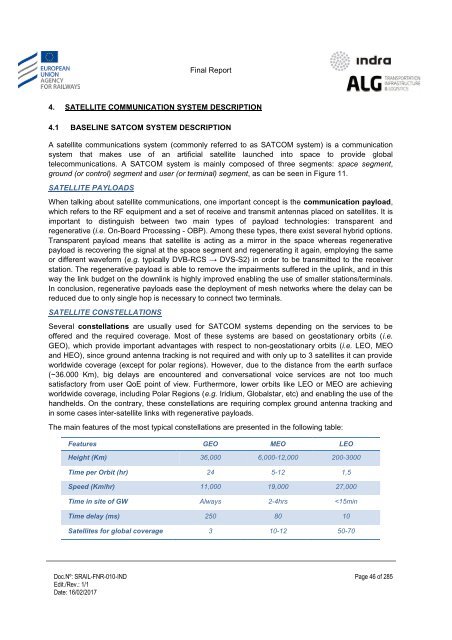Study on feasibility of SATCOM for railway communication
SRAIL-FNR-010-IND%20-%20FinalReport_v1.1_20170216
SRAIL-FNR-010-IND%20-%20FinalReport_v1.1_20170216
You also want an ePaper? Increase the reach of your titles
YUMPU automatically turns print PDFs into web optimized ePapers that Google loves.
Final Report<br />
4. SATELLITE COMMUNICATION SYSTEM DESCRIPTION<br />
4.1 BASELINE <strong>SATCOM</strong> SYSTEM DESCRIPTION<br />
A satellite communicati<strong>on</strong>s system (comm<strong>on</strong>ly referred to as <strong>SATCOM</strong> system) is a communicati<strong>on</strong><br />
system that makes use <strong>of</strong> an artificial satellite launched into space to provide global<br />
telecommunicati<strong>on</strong>s. A <strong>SATCOM</strong> system is mainly composed <strong>of</strong> three segments: space segment,<br />
ground (or c<strong>on</strong>trol) segment and user (or terminal) segment, as can be seen in Figure 11.<br />
SATELLITE PAYLOADS<br />
When talking about satellite communicati<strong>on</strong>s, <strong>on</strong>e important c<strong>on</strong>cept is the communicati<strong>on</strong> payload,<br />
which refers to the RF equipment and a set <strong>of</strong> receive and transmit antennas placed <strong>on</strong> satellites. It is<br />
important to distinguish between two main types <strong>of</strong> payload technologies: transparent and<br />
regenerative (i.e. On-Board Processing - OBP). Am<strong>on</strong>g these types, there exist several hybrid opti<strong>on</strong>s.<br />
Transparent payload means that satellite is acting as a mirror in the space whereas regenerative<br />
payload is recovering the signal at the space segment and regenerating it again, employing the same<br />
or different wave<strong>for</strong>m (e.g. typically DVB-RCS → DVS-S2) in order to be transmitted to the receiver<br />
stati<strong>on</strong>. The regenerative payload is able to remove the impairments suffered in the uplink, and in this<br />
way the link budget <strong>on</strong> the downlink is highly improved enabling the use <strong>of</strong> smaller stati<strong>on</strong>s/terminals.<br />
In c<strong>on</strong>clusi<strong>on</strong>, regenerative payloads ease the deployment <strong>of</strong> mesh networks where the delay can be<br />
reduced due to <strong>on</strong>ly single hop is necessary to c<strong>on</strong>nect two terminals.<br />
SATELLITE CONSTELLATIONS<br />
Several c<strong>on</strong>stellati<strong>on</strong>s are usually used <strong>for</strong> <strong>SATCOM</strong> systems depending <strong>on</strong> the services to be<br />
<strong>of</strong>fered and the required coverage. Most <strong>of</strong> these systems are based <strong>on</strong> geostati<strong>on</strong>ary orbits (i.e.<br />
GEO), which provide important advantages with respect to n<strong>on</strong>-geostati<strong>on</strong>ary orbits (i.e. LEO, MEO<br />
and HEO), since ground antenna tracking is not required and with <strong>on</strong>ly up to 3 satellites it can provide<br />
worldwide coverage (except <strong>for</strong> polar regi<strong>on</strong>s). However, due to the distance from the earth surface<br />
(~36.000 Km), big delays are encountered and c<strong>on</strong>versati<strong>on</strong>al voice services are not too much<br />
satisfactory from user QoE point <strong>of</strong> view. Furthermore, lower orbits like LEO or MEO are achieving<br />
worldwide coverage, including Polar Regi<strong>on</strong>s (e.g. Iridium, Globalstar, etc) and enabling the use <strong>of</strong> the<br />
handhelds. On the c<strong>on</strong>trary, these c<strong>on</strong>stellati<strong>on</strong>s are requiring complex ground antenna tracking and<br />
in some cases inter-satellite links with regenerative payloads.<br />
The main features <strong>of</strong> the most typical c<strong>on</strong>stellati<strong>on</strong>s are presented in the following table:<br />
Features GEO MEO LEO<br />
Height (Km) 36,000 6,000-12,000 200-3000<br />
Time per Orbit (hr) 24 5-12 1,5<br />
Speed (Km/hr) 11,000 19,000 27,000<br />
Time in site <strong>of</strong> GW Always 2-4hrs


